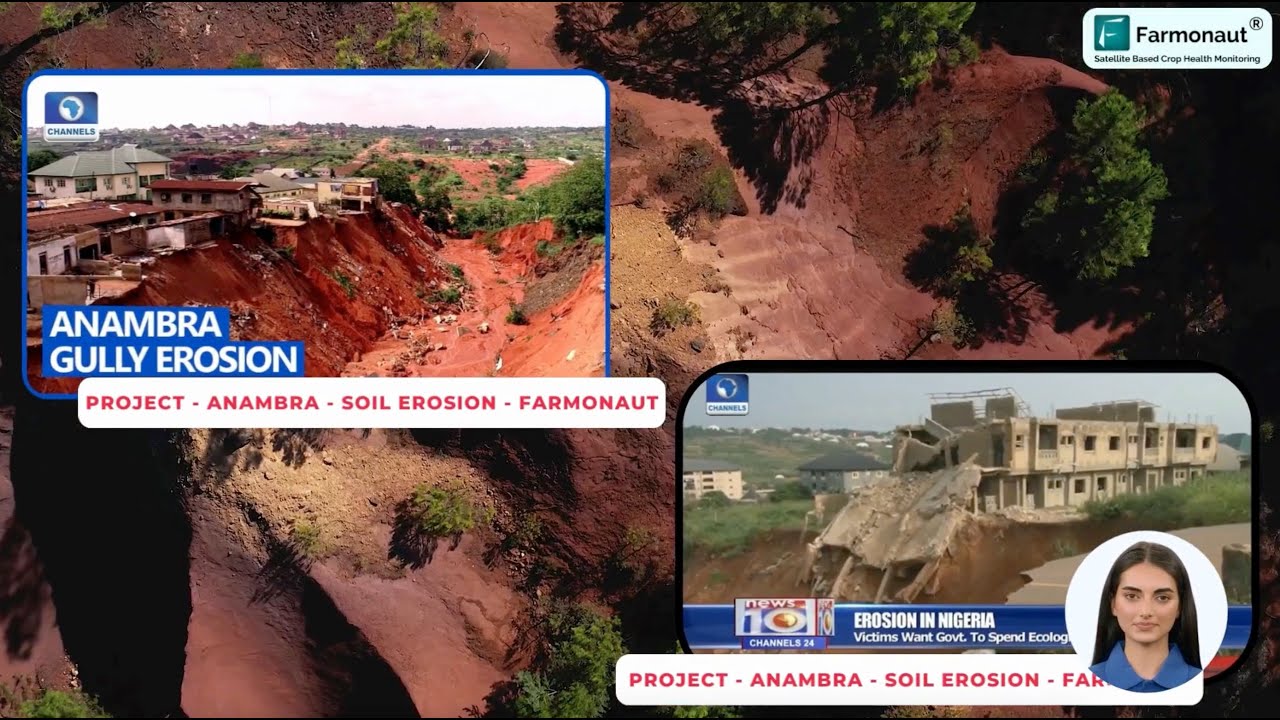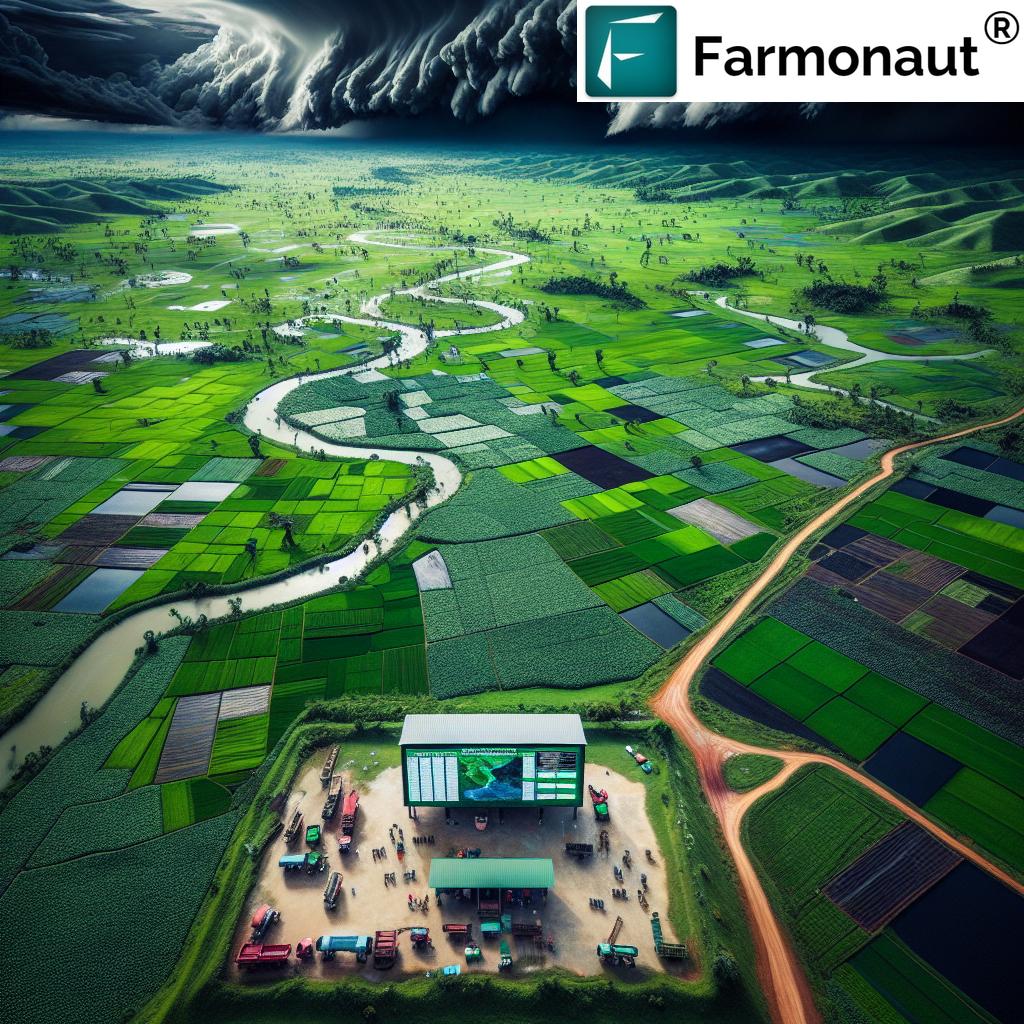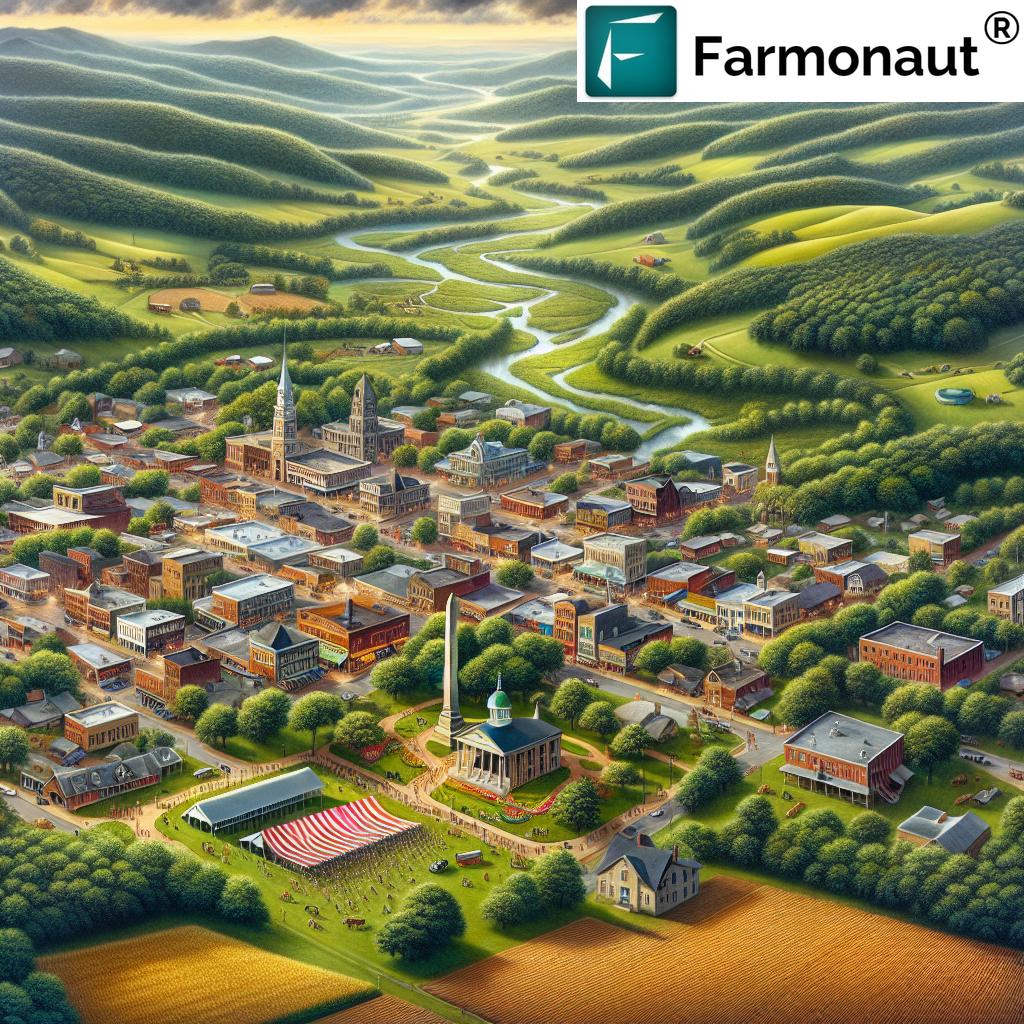Discover Kansas’ Hidden Treasures: 12 Scenic Byways Through Prairie, Hills, and History
“Kansas boasts 12 distinct scenic byways, covering diverse landscapes from Glacial Hills to Flint Hills National Scenic Byway.”
Welcome to the heart of America’s Great Plains, where Kansas unfolds its hidden treasures through a network of 12 scenic byways. We invite you to embark on an unforgettable road trip across the Sunflower State, exploring its unique beauty, rich history, and diverse topography. From rolling prairies to rugged hills, each byway offers a captivating journey through time and terrain.
In this comprehensive guide, we’ll take you on a virtual tour of Kansas’ scenic routes, showcasing the state’s natural wonders, historic landmarks, and charming communities. Whether you’re a nature enthusiast, history buff, or adventure seeker, these byways promise an enriching travel experience that will leave you in awe of Kansas’ landscapes and cultural heritage.
1. Glacial Hills Scenic Byway: A Journey Through Ancient Landscapes
Our journey begins in northeastern Kansas with the Glacial Hills Scenic Byway. This route gets its name from the rolling hills and rock-strewn valleys carved by ancient glaciers. As we travel along this byway, we’ll witness the legacy of these massive ice sheets that shaped the landscape thousands of years ago.
- Key Attractions: Glacial erratics (large boulders), fertile farmlands, and picturesque valleys
- Length: Approximately 63 miles
- Best Time to Visit: Spring and fall for vibrant colors and mild weather
The Glacial Hills Scenic Byway offers a unique glimpse into Kansas’ geological past. As we drive through the weathered hills and fertile valleys, we can imagine the immense force of the glaciers that once covered this region. The receding ice left behind not only a beautiful landscape but also highly productive farmland that continues to thrive today.
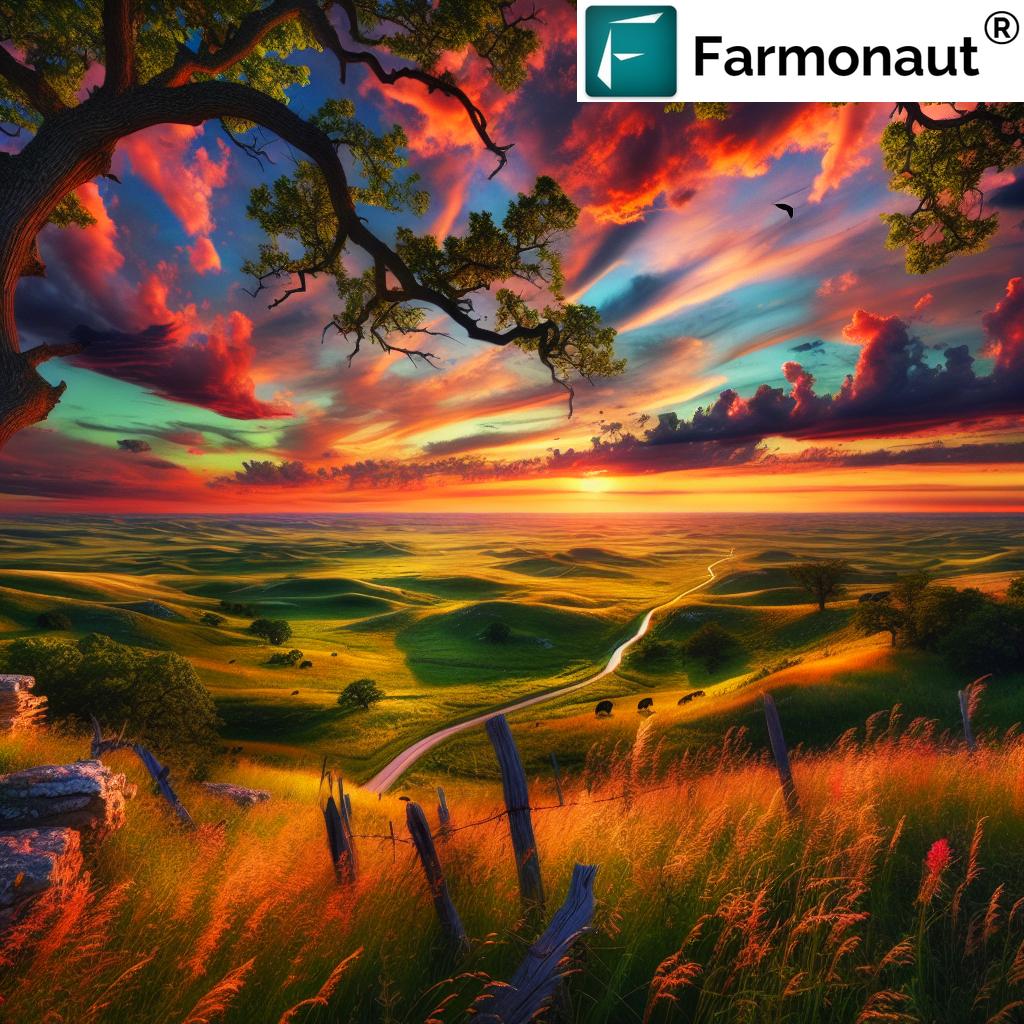
As we traverse this byway, we’ll encounter charming small towns and witness the harmonious blend of nature and agriculture. The fertile soil, a gift from the glaciers, supports a thriving agricultural industry. Farmers in this region benefit from advanced technologies like those offered by Farmonaut, which provides satellite-based crop health monitoring and AI-driven advisory services to optimize farm productivity.
2. Post Rock Scenic Byway: A Testament to Pioneer Ingenuity
Continuing our journey, we arrive at the Post Rock Scenic Byway, which winds through 18 miles of the Smoky Hills region. This route showcases the unique landscape shaped by weathered bedrock and the ingenuity of early settlers.
- Key Attractions: Limestone fence posts, rolling prairies, and historic towns
- Length: 18 miles
- Best Time to Visit: Late spring to early fall for pleasant weather and wildflower blooms
The Post Rock Scenic Byway derives its name from the distinctive limestone fence posts that dot the landscape. Early pioneers, faced with a shortage of wood, ingeniously used the abundant limestone to create durable fencing. These post rocks have become an iconic symbol of Kansas’ resourcefulness and adaptation to the challenging prairie environment.
As we drive along this byway, we’ll be surrounded by vast fields and pastures, showcasing the region’s agricultural heritage. Modern farmers in this area leverage cutting-edge technologies like Farmonaut’s API to monitor crop health and optimize resource management, ensuring the continued prosperity of this fertile land.
3. Western Vistas Scenic Byway: A Journey Through Ancient Seabeds
Our next stop takes us to the Western Vistas Scenic Byway, a route that transports us back in time to when Kansas was covered by an ancient ocean. This byway offers a fascinating glimpse into the state’s geological history and unique topography.
- Key Attractions: Chalk formations, buttes, and fossil-rich landscapes
- Length: Approximately 102 miles
- Best Time to Visit: Spring and fall for moderate temperatures and clear skies
As we travel along the Western Vistas Scenic Byway, we’ll encounter a landscape that seems almost otherworldly. The shortgrass prairie stretches as far as the eye can see, punctuated by oddly placed buttes, mounts, and chalk formations. These features are remnants of the ancient seabed, sculpted over millions of years by erosion and the elements.
The Western Vistas Scenic Byway not only showcases Kansas’ natural beauty but also its rich paleontological history. Fossil hunters and geology enthusiasts will find this route particularly exciting, with numerous opportunities to explore the region’s prehistoric past.
4. Flint Hills National Scenic Byway: The Heart of Tallgrass Prairie
No journey through Kansas would be complete without experiencing the Flint Hills National Scenic Byway. This 47-mile route takes us through one of the last remaining tallgrass prairie landscapes in North America.
- Key Attractions: Vast tallgrass prairies, native wildflowers, and panoramic vistas
- Length: 47 miles
- Best Time to Visit: Late spring to early summer for wildflower blooms and lush prairies
As we drive along the Flint Hills National Scenic Byway, we’re transported back in time to a landscape that has remained largely unchanged for thousands of years. The vast expanse of tallgrass prairie, once home to massive herds of bison and the hunting grounds of the Kaw, Osage, and other native tribes, stretches to the horizon.
This byway offers incredible views of native grasses and flowers, providing a glimpse into the diverse ecosystem that once covered much of the Great Plains. The Flint Hills region is not only a natural wonder but also an important agricultural area, where ranchers and farmers work in harmony with the land.
“The Sunflower State’s scenic routes showcase 5 unique topographical features: Smoky Hills, Western Vistas, Native Stone formations, Gypsum Hills, and prairies.”
5. Land and Sky Scenic Byway: A Tribute to Kansas Agriculture
Our journey now takes us to the Land and Sky Scenic Byway, the only route in Kansas that focuses primarily on agriculture. This 88-mile long byway offers a unique perspective on the state’s farming heritage and modern agricultural practices.
- Key Attractions: Vast crop fields, agricultural museums, and farming communities
- Length: 88 miles
- Best Time to Visit: Late summer to early fall for harvest season and crop diversity
As we traverse the Land and Sky Scenic Byway, we’ll witness thousands of acres of rotating crops, including wheat, corn, sorghum, soybeans, and the iconic sunflowers that give Kansas its nickname. This route provides a fascinating look at the life cycle of crops and the vital role agriculture plays in the state’s economy and culture.
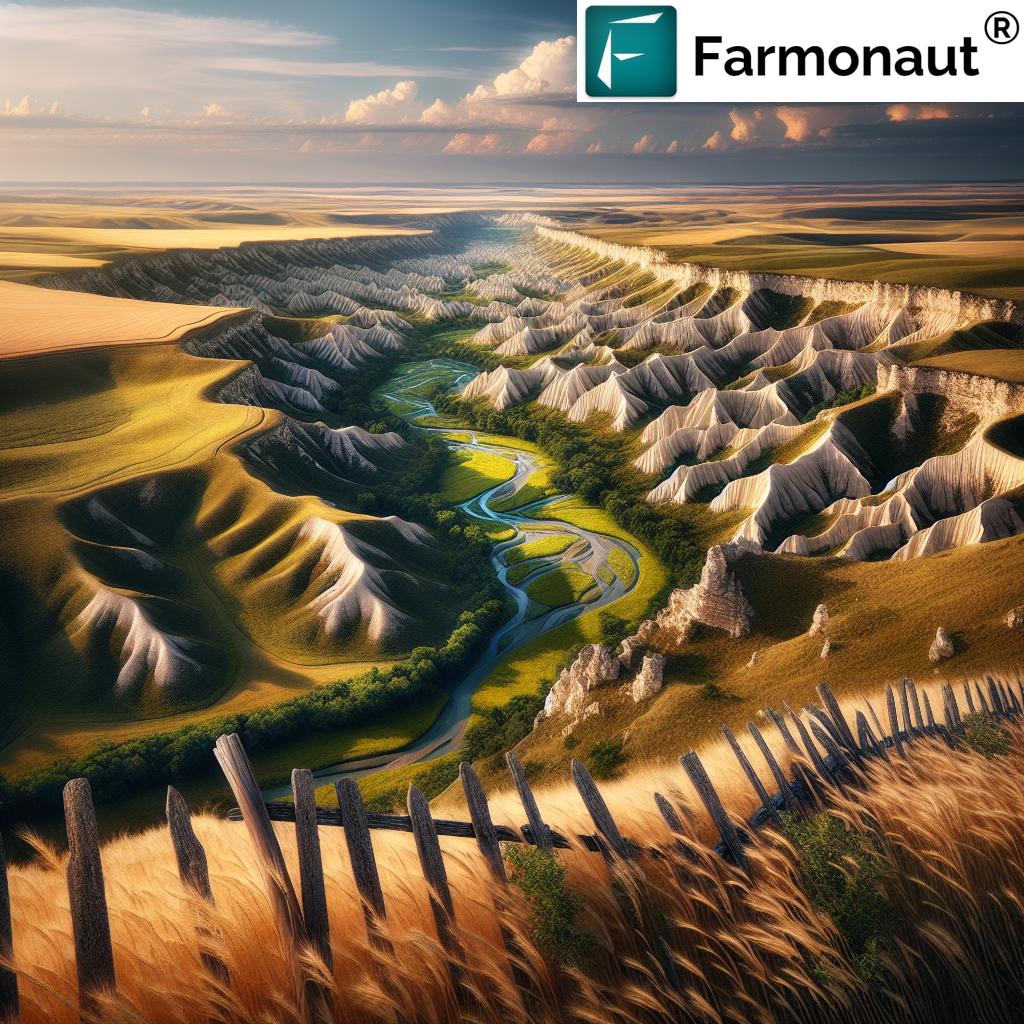
Along the byway, interpretive signage and kiosks tell the story of Kansas agriculture, from its early pioneering days to the advanced farming techniques used today. Modern farmers in this region often rely on innovative technologies like those provided by Farmonaut’s API to monitor crop health, optimize irrigation, and make data-driven decisions for improved yields and sustainability.
6. Native Stone Scenic Byway: A Journey Through Geological Wonders
Our next stop is the Native Stone Scenic Byway, a 75-mile route that showcases the natural beauty and geological richness of Kansas’ limestone formations. This byway offers a unique perspective on how the state’s natural resources have shaped its architecture and culture.
- Key Attractions: Limestone formations, historic stone buildings, and quarries
- Length: 75 miles
- Best Time to Visit: Spring and fall for comfortable temperatures and clear views
As we drive along the Native Stone Scenic Byway, we’ll encounter stunning limestone outcroppings and hillsides that have been a part of Kansas’ landscape for millions of years. The route takes us through areas where this abundant natural resource has been used in everything from humble farm fences to grand courthouses and other architectural marvels.
The byway not only showcases the natural beauty of these limestone formations but also tells the story of how early settlers and builders utilized this versatile stone to create lasting structures. Many of these historic buildings still stand today, a testament to the durability and timeless appeal of native Kansas limestone.
7. Wetlands and Wildlife National Scenic Byway: A Haven for Nature Lovers
Our journey now takes us to the Wetlands and Wildlife National Scenic Byway, a route that offers a unique glimpse into Kansas’ diverse ecosystems and rich biodiversity. This byway showcases the state’s commitment to conservation and provides unparalleled opportunities for wildlife viewing.
- Key Attractions: Cheyenne Bottoms Wildlife Area, Quivira National Wildlife Refuge, migratory bird populations
- Length: 77 miles
- Best Time to Visit: Spring and fall for bird migrations, year-round for diverse wildlife
As we travel along this scenic byway, we’ll encounter landscapes shaped by powerful forces of nature. The route takes us through two of the world’s most important wetland ecosystems: Cheyenne Bottoms and Quivira National Wildlife Refuge. These areas serve as critical stopover points for millions of migratory birds, making this byway a paradise for birdwatchers and nature enthusiasts.
The Wetlands and Wildlife National Scenic Byway not only offers spectacular natural beauty but also provides insights into the delicate balance of these ecosystems. Visitors can learn about conservation efforts and the importance of preserving these vital habitats for future generations.
8. Smoky Valley Scenic Byway: A Journey Through Kansas’ Heartland
Our next destination is the Smoky Valley Scenic Byway, a 60-mile route that takes us through the heart of the Smoky Hills region. This byway offers a perfect blend of natural beauty and rural charm, showcasing the essence of Kansas’ landscapes.
- Key Attractions: Smoky Hill River Valley, native grasslands, historic sites
- Length: 60 miles
- Best Time to Visit: Late spring to early fall for lush landscapes and outdoor activities
As we drive along the Smoky Valley Scenic Byway, we’ll be treated to panoramic views of the Smoky Hill River Valley. The route winds through a landscape where the eastern mixed-grass prairie transitions into the shortgrass prairie of the Western Great Plains, offering a unique perspective on Kansas’ diverse ecosystems.
This byway is named for the hazy blue appearance of the hills at sunrise and sunset, creating a mesmerizing visual effect that captivates travelers. Along the route, we’ll encounter charming rural communities, historic sites, and opportunities to experience the warm hospitality of Kansas’ heartland.
9. Frontier Military Historic Byway: Tracing the Footsteps of History
Our journey now takes us along the Frontier Military Historic Byway, a 168-mile route that offers a fascinating glimpse into Kansas’ military history and its role in the westward expansion of the United States.
- Key Attractions: Historic forts, Civil War sites, pioneer settlements
- Length: 168 miles
- Best Time to Visit: Spring and fall for comfortable weather and historical reenactments
As we travel the Frontier Military Historic Byway, we’ll follow in the footsteps of soldiers, settlers, and Native Americans who shaped the region’s history. This route, originally built to move troops and supplies, has witnessed significant events in American history, from the tensions leading up to the Civil War to the challenges of frontier life.
Along the byway, we’ll encounter several well-preserved forts, each telling its own story of life on the frontier. These historic sites offer a tangible connection to the past, allowing visitors to experience firsthand the challenges and triumphs of those who came before us.
10. Kansas’ Route 66 Historic Byway: A Journey Along America’s Main Street
No exploration of Kansas’ scenic byways would be complete without a trip down the iconic Route 66. The Kansas portion of this historic highway may be short, but it’s packed with nostalgia and charm.
- Key Attractions: Vintage diners, classic gas stations, quirky roadside attractions
- Length: 13.2 miles (in Kansas)
- Best Time to Visit: Late spring to early fall for pleasant weather and active attractions
As we drive along Kansas’ Route 66 Historic Byway, we’ll step back in time to the golden age of American road trips. This short but sweet stretch of the “Mother Road” offers a concentrated dose of nostalgia, with vintage neon signs, classic diners, and unique attractions that harken back to the mid-20th century.
Despite its brevity, the Kansas section of Route 66 packs in plenty of character. From the restored Baxter Springs Independent Oil and Gas Service Station to the quirky Cars on the Route in Galena, there’s no shortage of photo opportunities and memorable experiences along this historic highway.
11. Prairie Trail Scenic Byway: A Journey Through Time and Nature
Our penultimate stop is the Prairie Trail Scenic Byway, a route that takes us through the heart of Kansas’ prairie lands and offers a glimpse into the state’s rich natural and cultural history.
- Key Attractions: Maxwell Wildlife Refuge, Kanopolis State Park, historic Lindsborg
- Length: 80 miles
- Best Time to Visit: Spring for wildflower blooms, fall for autumn colors
As we travel the Prairie Trail Scenic Byway, we follow in the footsteps of Native Americans, explorers, and pioneers who sought food, shelter, and adventure in these lands. The route takes us through diverse landscapes, from native prairies to rolling hills and scenic lakes.
One of the highlights of this byway is the Maxwell Wildlife Refuge, home to herds of bison and elk. This protected area offers a glimpse into what the Great Plains might have looked like before widespread settlement. The byway also passes through the charming town of Lindsborg, known as “Little Sweden,” where visitors can experience a unique blend of Scandinavian and Kansas culture.
12. Gypsum Hills Scenic Byway: A Journey Through Kansas’ Red Hills
Our final destination is the Gypsum Hills Scenic Byway, a 42-mile route that showcases one of Kansas’ most unique and visually striking landscapes.
- Key Attractions: Red rock formations, mesas, canyons, and unique flora
- Length: 42 miles
- Best Time to Visit: Spring for wildflowers, fall for clear skies and mild temperatures
As we drive along the Gypsum Hills Scenic Byway, we’ll be transported to a landscape that seems more reminiscent of the American Southwest than the Great Plains. The route winds through the Red Hills, also known as the Gyp Hills, showcasing a terrain of buttes, mesas, canyons, and sinkholes that is rare in this part of the country.
The vibrant red soil, contrasted against the green vegetation and blue sky, creates a stunning visual spectacle. This byway offers numerous opportunities for outdoor recreation, including hiking, photography, and stargazing in one of Kansas’ darkest night sky areas.
Conclusion: Embracing Kansas’ Diverse Beauty
As we conclude our journey through Kansas’ 12 scenic byways, we’re left with a deep appreciation for the state’s diverse landscapes, rich history, and natural wonders. From the glacial hills of the northeast to the red rocks of the southwest, Kansas offers a tapestry of experiences that challenge preconceptions and inspire wonder.
These scenic routes not only showcase the state’s beauty but also tell the story of its people – from ancient Native American tribes to pioneering settlers and modern-day farmers. They remind us of the enduring relationship between humans and the land, a relationship that continues to evolve with advancements in agricultural technology and conservation practices.
As we’ve seen throughout our journey, modern farming plays a crucial role in preserving and nurturing these landscapes. Companies like Farmonaut are at the forefront of this agricultural revolution, providing farmers with tools to optimize crop yields while promoting sustainable practices. Through satellite-based crop health monitoring and AI-driven advisory services, Farmonaut is helping to ensure that Kansas’ agricultural heritage continues to thrive alongside its natural beauty.
Whether you’re a nature enthusiast, history buff, or simply looking for a unique road trip experience, Kansas’ scenic byways offer something for everyone. We encourage you to explore these routes, immerse yourself in the state’s diverse landscapes, and create your own unforgettable memories along the way.
FAQ Section
Q: What is the best time of year to explore Kansas’ scenic byways?
A: While each season offers its own charm, spring and fall are generally considered the best times to explore Kansas’ scenic byways. Spring brings wildflower blooms and pleasant temperatures, while fall offers stunning autumn colors and clear skies.
Q: Are these scenic byways suitable for RV travel?
A: Most of Kansas’ scenic byways are suitable for RV travel, with good road conditions and ample parking at major attractions. However, it’s always a good idea to check current road conditions and any specific route restrictions before embarking on your journey.
Q: How long does it take to explore all 12 scenic byways?
A: The time required to explore all 12 scenic byways depends on your travel pace and the number of stops you make. A comprehensive tour could take anywhere from a week to several weeks. We recommend allowing at least 1-2 days for each byway to fully appreciate the sights and experiences along the way.
Q: Are there accommodation options along these scenic routes?
A: Yes, you’ll find a variety of accommodation options along or near these scenic byways, ranging from campgrounds and RV parks to hotels and bed & breakfasts in nearby towns. It’s advisable to book in advance, especially during peak travel seasons.
Q: Can I access these scenic byways using public transportation?
A: While public transportation options are limited in rural Kansas, some portions of these byways may be accessible via local bus services. However, for the best experience and flexibility, we recommend exploring these routes by car or as part of an organized tour.
Earn With Farmonaut: Affiliate Program
Earn 20% recurring commission with Farmonaut’s affiliate program by sharing your promo code and helping farmers save 10%. Onboard 10 Elite farmers monthly to earn a minimum of $148,000 annually—start now and grow your income!



